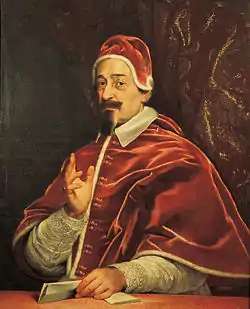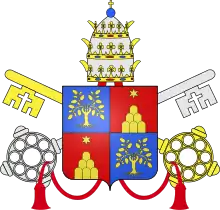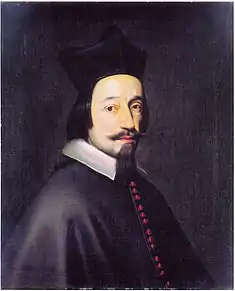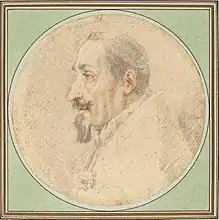Pope Alexander VII
Pope Alexander VII (13 February 1599 – 22 May 1667), born Fabio Chigi, was head of the Catholic Church and ruler of the Papal States from 7 April 1655 to his death in 1667.[1][2]
Pope Alexander VII | |
|---|---|
| Bishop of Rome | |
 Portrait by Giovanni Battista Gaulli | |
| Diocese | Diocese of Rome |
| See | Holy See |
| Papacy began | 7 April 1655 |
| Papacy ended | 22 May 1667 |
| Predecessor | Innocent X |
| Successor | Clement IX |
| Orders | |
| Ordination | December 1634 |
| Consecration | 1 July 1635 by Miguel Juan Balaguer Camarasa |
| Created cardinal | 19 February 1652 by Innocent X |
| Personal details | |
| Birth name | Fabio Chigi |
| Born | 13 February 1599 Siena, Grand Duchy of Tuscany |
| Died | 22 May 1667 (aged 68) Rome, Papal States |
| Previous post |
|
| Motto | Montium custos ("Mountain guardian") |
| Coat of arms | |
| Other popes named Alexander | |
He began his career as a vice-papal legate, and he held various diplomatic positions in the Holy See. He was ordained as a priest in 1634, and he became bishop of Nardo in 1635. He was later transferred in 1652, and he became bishop of Imola. Pope Innocent X made him secretary of state in 1651, and in 1652, he was appointed a cardinal.
Early in his papacy, Alexander, who was seen as an anti-nepotist at the time of his election, lived simply; later, however, he gave jobs to his relatives, who eventually took over his administration.
His administration worked to support the Jesuits. However, his administration's relations with France were strained due to his frictions with French diplomats.
Alexander was interested in architecture and supported various urban projects in Rome. He also wrote poetry and patronized artists who expanded the decoration of churches. His theological writings included discussions of heliocentrism and the Immaculate Conception.
Biography
Early life
Born in Siena, a member of the illustrious banking family of Chigi and a great-nephew of Pope Paul V (1605–1621),[3] Fabio Chigi was privately tutored and eventually received doctorates of philosophy, law, and theology from the University of Siena.
Fabio's elder brother, Mario, married Berenice, the daughter of Tiberio della Ciala, producing four children, of whom two survived: Agnes and Flavio. Flavio (1631–1693) was created cardinal by his uncle on 9 April, 1657. His brother, Augusto Chigi (1595–1651), married Olimpia della Ciaia (1614–1640) and continued the family line as the parents of Agostino Chigi, Prince Farnese. Fabio's sister Onorata Mignanelli married Firmano Bichi; their son Antonio was named Bishop of Montalcino (1652–1656) and then of Osimo (1656–1659), and was named a cardinal (in pectore) by his uncle, Alexander VII, on 9 April 1657. The appointment was made public on 10 November 1659.[4] Another of his nephews was Giovanni Bichi, whom he appointed Admiral of the Papal Navy.[5]
Papal diplomat
In 1627 he began his apprenticeship as vice-papal legate at Ferrara, and on recommendations from two cardinals he was appointed Inquisitor of Malta.[6][7]
Chigi was ordained a priest in December 1634. He was appointed Referendarius utriusque signaturae, which made him a prelate and gave him the right to practice before the Roman courts. On 8 January 1635, Chigi was named Bishop of Nardò in southern Italy and consecrated on 1 July 1635[8] by Miguel Juan Balaguer Camarasa, Bishop of Malta.[9] On 13 May 1652 he was transferred to the Bishopric of Imola.[8]
Bishop Chigi was named nuncio in Cologne (1639–1651) on 11 June 1639. There, he supported Urban VIII's condemnation of the heretical book Augustinus by Cornelius Jansen, Bishop of Ypres, in the papal Bull In eminenti of 1642.[10]
Though expected to take part in the negotiations which led in 1648 to the Peace of Westphalia, Bishop Chigi (and other Catholic delegates) declined to deliberate with persons whom the Catholic Church considered heretics. Negotiations therefore took place in two cities, Osnabrück and Münster in Westphalia, with intermediaries travelling back and forth between the Protestant and the Catholic delegates. Chigi, of course, protested on behalf of the Papacy, when the treaties were finally completed, against the Treaty of Westphalia once the instruments were finally completed.[11][12] Pope Innocent himself stated that the Peace "is null, void, invalid, unjust, damnable, reprobate, inane, empty of meaning and effect for all time."[13] The Peace ended the Thirty Years' War (1618–1648) and established the balance of European power that lasted until the wars of the French Revolution (1789).
Secretary of State and Cardinal
Pope Innocent X (1644–1655) recalled Chigi to Rome. In December 1651 Pope Innocent named Cardinal Chigi Secretary of State.[14][15] He was created cardinal by Innocent X in the Consistory of 19 February 1652, and on 12 March was granted the title of Cardinal-Priest of Santa Maria del Popolo.[16]
Papacy
Election as pope
| Papal styles of Pope Alexander VII | |
|---|---|
 | |
| Reference style | His Holiness |
| Spoken style | Sanct(issim)e Pater |
| Religious style | Holy Father |
| Posthumous style | None |
When Innocent X died on 1 January 1655, Cardinal Chigi was elected pope after eighty days in the conclave, on 7 April 1655, taking the name of Alexander VII.[17]
Nepotism
The conclave believed he was strongly opposed to the nepotism that had been a feature of previous popes. Indeed, in the first year of his reign, Alexander VII lived simply and forbade his relations even to visit Rome. A contemporary, John Bargrave (having visited Rome during the period following his election and then later during his papacy) wrote the following:[18]
In the first months of his elevation to the Popedom, he had so taken upon him the profession of an evangelical life that he was wont to season his meat with ashes, to sleep upon a hard couch, to hate riches, glory, and pomp, taking a great pleasure to give audience to ambassadors in a chamber full of dead men's sculls, and in the sight of his coffin, which stood there to put him in mind of his death. [His] extraordinary devotion and sanctity of life I found was so much esteemed that the noise of it spread far and near. But so soon as he had called his relations about him he changed his nature. Instead of humility succeeded vanity; his mortification vanished, his hard couch was turned into a soft featherbed, his dead men's sculls into jewels, and his thoughts of death into ambition — filling his empty coffin with money as if he would corrupt death, and purchase life with riches.
The prose may be grossly exaggerated, as the view of a Protestant clergyman and nephew of the Dean of Canterbury, but, indeed, it is at least true that in the consistory of 24 April 1656 Pope Alexander announced that his brother and nephews would be coming to assist him in Rome. His nephew, Cardinal Flavio Chigi assumed the position of cardinal-nephew. The administration was given largely into the hands of his relatives,[19] and nepotism became as luxuriously entrenched as it ever had been in the Baroque Papacy: he gave them the best-paid civil and ecclesiastical offices, and princely palaces and estates suitable to the Chigi of Siena. Cardinal Flavio began work on the Villa Chigi-Versaglia at Formello in 1664.[20]
Urban and architectural projects in Rome


A number of pontifs are renowned for their urban planning in the city of Rome—for example, Pope Julius II and Pope Sixtus V—but Alexander VII's numerous urban interventions were not only diverse in scope and scale but demonstrated a consistent planning and architectural vision that the glorification and embellishment of the city, ancient and modern, sacred and secular, should be governed by order and decorum.[21][22]
Central to Alexander's urbanism was the idea of teatro or urban theatre[23] whereby his urban interventions became the grand settings or showpieces appropriate to the dignity of Rome and the Head of the Catholic Church. Therefore, and although the scales are vastly different, the small Santa Maria della Pace and its piazza are as much a teatro as the imposing monumental colonnade that forms Piazza San Pietro in front of St. Peter's Basilica.
The various urban and architectural projects carried out during Alexander's reign were recorded in engravings by Giovanni Battista Falda and the first volume was published in 1665. The volumes were published by Giovanni Giacomo de Rossi under the title Il Nuovo Teatro delle fabriche et edificij in prospettiva di Roma moderna sotto il felice pontificato di N.S. Alessandro VII.[24] A rival publication documenting these projects was published by Rossi's cousin Giovanni Battista de Rossi who employed the young Flemish architectural draughtsman Lieven Cruyl to produce drawings of Rome, 10 of which were published in 1666 under the title Prospectus Locorum Urbis Romae Insignium.[25]
His preferred architect was the sculptor and architect Gianlorenzo Bernini[26] but he also gave architectural commissions to the painter and architect Pietro da Cortona. Of the three leading architects of the Roman High Baroque, only Francesco Borromini fared not so well under Alexander; this may be because he thought Borromini's architectural forms willful but also Borromini could be notoriously difficult. Nonetheless, Alexander's family heraldic emblems of the mons or mountains with stars and oak leaves, adorn Borromini's[27] church of Sant'Ivo alla Sapienza and many other works of his reign.[28]
Alexander took a keen personal interest in his urban and architectural projects and made notes of these in his diaries.[29] His projects in Rome included: the church and piazza at Santa Maria della Pace; the Via del Corso, Piazza Colonna and associated buildings; reworking of the Porta del Popolo, the Piazza del Popolo and Santa Maria del Popolo; Piazza San Pietro,[30] the Scala Regia and interior embellishments in the Vatican Palace and St. Peter's; Sant'Andrea al Quirinale; part of the Palazzo del Quirinale; the arsenal at Civitavecchia,[31] the obelisk and elephant in Piazza della Minerva; and the Palazzo Chigi.[32] The Palazzo Chigi in Rome is not to be confused with the Palazzo Chigi in S. Quirico d'Orcia in Tuscany,[33] or the Palazzo Chigi di Formello.[34]
Foreign relations

Malta
Before being elected as Pontiff, Chigi served as Inquisitor on the Island of Malta where he resided mostly at the Inquisitor's Palace in Birgu (alias Città Vittoriosa). At that time Malta was a fiefdom of the Knights Hospitallers of the Sovereign Order of Saint John of Jerusalem, Knights of Malta.
Sweden
The conversion of Queen Christina of Sweden (1632–1654) occurred during Alexander VII's reign. After her abdication the queen came to reside in Rome, where she was confirmed in her baptism by the Pope, in whom she found a generous friend and benefactor, on Christmas Day, 1655.
France
In foreign policy his instincts were not as humanist or as successful. Alexander VII's pontificate was shadowed by continual friction with Cardinal Mazarin, adviser to Louis XIV of France (1643–1715), who had opposed him during the negotiations that led to the Peace of Westphalia and who defended the prerogatives of the Gallican Church. During the conclave, he had been hostile to Chigi's election, but was in the end compelled to accept him as a compromise. However, he prevented Louis XIV from sending the usual embassy of obedience to Alexander VII, and, while he lived, he foiled the appointment of a French ambassador to Rome, diplomatic affairs being meantime conducted by cardinal protectors, generally personal enemies of the Pope. In 1662, the equally hostile Duc de Crequi was made ambassador. By his abuse of the traditional right of asylum granted to ambassadorial precincts in Rome, he precipitated a quarrel between France and the papacy, which resulted in Alexander VII's temporary loss of Avignon and his forced acceptance of the humiliating treaty of Pisa in 1664.[35]
Jesuits and Jansenism
Alexander VII favoured the Jesuits. When the Venetians called for help in Crete against the Ottoman Turks, the Pope extracted in return a promise that the Jesuits should be permitted back in Venetian territory, from which they had been expelled in 1606. He also continued to take the Jesuit part in their conflict with the Jansenists, whose condemnation he had vigorously supported as advisor to Pope Innocent X. The French Jansenists professed that the propositions condemned in 1653 were not in fact to be found in Augustinus, written by Cornelius Jansen. Alexander VII confirmed that they were too, by the bull Ad Sanctam Beati Petri Sedem (16 October 1656) declaring that five propositions extracted by a group of theologians from the Sorbonne out of Jansen's work, mostly concerning grace and the fallen nature of man, were heretical, including the proposition according to which to say "that Christ died, or shed His blood for all men" would be a semipelagian error. He also sent to France his famous "formulary", that was to be signed by all the clergy as a means of detecting and extirpating Jansenism and which inflamed public opinion, leading to Blaise Pascal's defense of Jansenism.
Works
Alexander VII disliked the business of state, preferring literature and philosophy; a collection of his Latin poems appeared at Paris in 1656 under the title Philomathi Labores Juveniles. He also encouraged architecture, and the general improvement of Rome, where houses were razed to straighten and widen streets and where he had the opportunity to be a great patron for Gian Lorenzo Bernini: the decorations of the church of Santa Maria del Popolo, titular churches for several of the Chigi cardinals, the Scala Regia, the Chair of St. Peter in the Vatican Basilica. In particular, he sponsored Bernini's construction of the beautiful colonnade in the piazza of St. Peter's Basilica.
Alexander VII wrote one of the most authoritative documents related to the heliocentrism issue. He published his Index Librorum Prohibitorum Alexandri VII Pontificis Maximi jussu editus which presented anew the contents of the Index of Forbidden Books which had condemned the works of Copernicus and Galileo. According to Rev. William Roberts, he prefaced this with the bull Speculatores Domus Israel, stating his reasons: "in order that the whole history of each case may be known." 'For this purpose,' the Pontiff stated, 'we have caused the Tridentine and Clementine Indices to be added to this general Index, and also all the relevant decrees up to the present time, that have been issued since the Index of our predecessor Clement, that nothing profitable to the faithful interested in such matters might seem omitted."[36] Among those included were the previous decrees placing various heliocentric works on the Index ("...which we will should be considered as though it were inserted in these presents, together with all, and singular, the things contained therein...") and using his Apostolic authority he bound the faithful to its contents ("...and approve with Apostolic authority by the tenor of these presents, and: command and enjoin all persons everywhere to yield this Index a constant and complete obedience...")[37] Thus, Alexander turned definitively against the heliocentric view of the solar system. After Alexander VII's pontificate, the Index underwent a number of revisions.[38] "In 1758 the general prohibition against works advocating heliocentrism was removed from the Index of prohibited books, although the specific ban on uncensored versions of the Dialogue and Copernicus's De Revolutionibus remained. All traces of official opposition to heliocentrism by the church disappeared in 1835 when these works were finally dropped from the Index".[39] The Index was abolished entirely in 1966.[40]
Theology
Alexander VII's Apostolic Constitution, Sollicitudo omnium ecclesiarum (8 December 1661),[41] laid out the doctrine of the Immaculate Conception of the Blessed Virgin Mary in terms almost identical to those utilized by Pope Pius IX when he issued his infallible definition Ineffabilis Deus. Pius X cites Alexander VII's bull in his footnote 11.
Death
.jpg.webp)
Last moments and death
Alexander VII died at age 66 from kidney failure. He kept his coffin in his bedroom, and a skull (carved by famed sculptor Bernini) on his writing table, because he was always aware that he would someday die. A seventeenth-century pamphlet credited to Ayres, titled A short Account of the Life and Death of Pope Alexander VII, contains many fascinating details about Alexander's passing. According to this pamphlet, Alexander, although bedridden, wanted to celebrate the Passion to ready himself for his impending death. Neither his surgeon nor his confessor was able to persuade him to save his strength. He blessed the large crowd of people on Easter, the last time they would ever see him alive.[42]
| A short Account of the Life and Death of Pope Alexander VII[43] |
|---|
|
Alexander VII died in 1667 and was memorialised in a spectacular tomb by Bernini. It is famous for the skeleton holding a gilded hourglass, just above the doors. He was succeeded by Pope Clement IX (1667–69).
Memory
The poet John Flowre wrote a poem about the tomb of Pope Alexander (in 1667).[44]
See also
References
- Williams, George L. (1998). Papal Genealogy: The Families and Descendants of the Popes. McFarland & Company. p. 114.
- Note on numbering: Pope Alexander V is now considered an anti-pope. At the time however, this fact was not recognised and so the fifth true Pope Alexander took the official number VI. This caused the true sixth Pope Alexander to take the number VII. This has advanced the numbering of all subsequent Popes Alexander by one. Popes Alexander VI-VIII are really the fifth through seventh popes by that name.
- George L. Williams, 114.
- Lorenzo Grottanelli, "La regina Cristina di Svezia in Roma", La Rassegna nazionale 50 (Firenze 1889), 225–253, at p. 250.
- Mifsud, A. (1914). Knights Hospitallers of the Ven. Tongue of England in Malta. ISBN 9780404170097.
- V. Borg, Fabio Chigi, Apostolic Delegate in Malta, 1634–1639. An edition of his official correspondence (Città del Vaticano: Biblioteca Apostolica Vaticana, 1967).
- Winter, Johanna Maria (1998). Sources Concerning the Hospitallers of St. John in the Netherlands, 14th-18th Centuries. Brill. p. 133.
- Patritius Gauchat, Hierarchia catholica medii et recentioris aevi Tomus IV, editio altera (Monasterii 1935), p. 257, and note 5.
- "Pope Alexander VII - Fabio Chigi" Catholic-Hierarchy.org. David M. Cheney. Retrieved 2 July 2016
- Joseph Bergin, Church, Society and Religious Change in France, 1580–1730 (New Haven: Yale University Press, 2009), pp. 396–404.
- Baron, Salo Wittmayer (1969). A Social and Religious History of the Jews: Late Middle Ages and the Era of European Expansion. 10. Columbia University Press. p. 290.
- Derek Croxton and Anuschka Tischer, The Peace of Westphalia : a historical dictionary (Westport, Conn.: Greenwood Press, 2002).
- Kalevi Jaakko Holsti, Peace and War: Armed Conflicts and International Order, 1648–1989 (Cambridge: Cambridge University Press 1991), p. 25.
- Salvador Miranda, Biographical notes on Fabio Chigi. Retrieved; 19 March 2016.
- Merz, Jorg M.; Blunt, Anthony F. (2008). Pietro da Cortona and Roman Baroque Architecture. Yale University Press. p. 165.
- Gauchat, p. 30.
- J. P. Adams, Sede Vacante 1655. Retrieved: 19 March 2016.
- Bargrave, John (2009). Robertson, James Craigie (ed.). Pope Alexander the Seventh and the College of Cardinals (Reprint ed.).
- "CATHOLIC ENCYCLOPEDIA: Pope Alexander VII".
- Oliva Muratore, "Formello, Villa Versaglia," Methodical Approach to the Restoration of Historic Architecture (ed. Calogero Bellanca) (Firenze: Alinea Editrice, 2011), pp. 123–135.
- Krautheimer, Richard (1985). The Rome of Alexander VII 1655–1667. Princeton University Press. ISBN 978-0691040325.
- Habel, Dorothy Metzger (2002). The Urban Development of Rome in the Age of Alexander VII. Cambridge University Press. ISBN 978-0521772648.
- Krautheimer 1985, 3–7
- Full title: Il Nuovo Teatro delle fabriche et edificij in prospettiva di Roma moderna sotto il felice pontificato di N.S. Alessandro VII , (The New Theatre of the building works and edifices of modern Rome under the happy pontificate of Our Lord Alexander VII), published by Giovanni Giacomo de Rossi
- "Lievin Cruyl, Prospectus Locorum Urbis Romae Insignium" (PDF). Archived from the original (PDF) on 22 April 2016. Retrieved 2 April 2014.
- Charles Avery, Bernini: Genius of the Baroque (London: Thames & Hudson, 1997). Franco Mormando, Bernini: His Life and His Rome (Chicago: University of Chicago Press, 2011).
- Anthony Blunt, Borromini (Cambridge, Mass.: Belknap Press of Harvard University Press 1979), esp. pp. 111 ff.
- Alexander’s forebear, Agostino Chigi, was banker to Julius II, who granted Agostino the right to a coat-of-arms which quartered the oak, the heraldic emblem of the della Rovere, Julius’s family, with his own family's arms.
- See Krautheimer, R.; Jones, R. B. S. (1975). "The Diary of Alexander VII, notes on Art, Artists and Buildings". Römisches Jahrbuch für Kunstgeschichte. 15. ISBN 978-3803045034.
- Dorothy Metzger Habel, "When All of Rome was Under Construction": The Building Process in Baroque Rome (University Park, Pa.: Pennsylvania State University Press, 2013), pp. 85–132.
- "Alexander VII ( Chigi )".
- Rossella Vodret Adamo, Palazzo Chigi (Milan: Electa, 2001).
- Odoardo Reali, Palazzo Chigi a San Quirico: un restauro in corso (San Quirico d'Orcia [Italy]: Editrice DonChisciotte, 1997).
- Iefke van Kampen, Il nuovo Museo dell'Agro Veientano a Palazzo Chigi di Formello (Roma: Quasar, 2012).
- Paul Sonnino, Louis XIV's View of the Papacy (1661–1667) (Berkeley-Los Angeles: University of California Press, 1966), p. 53.
- The Pontifical Decrees Against the Doctrine of the Earth's Movement, and the Ultramontane Defence of Them, Rev. William Roberts, 1885, London, p.93.
- Roberts, p.94. Cf. Maurice A. Finocchiaro, Retrying Galileo, 1633–1992 (Berkeley-Los Angeles: University of California Press 2005), pp. 258–259.
- Joseph Hebers, Herbermann, Charles, ed. (1913). . Catholic Encyclopedia. New York: Robert Appleton Company.
- Galileo#Church reassessments of Galileo in later centuries
- Index of Forbidden Books#Abolition (1966)
- Bullarum Diplomatum et Privilegiorum Sanctorum Romanorum Pontificium Taurensis Editio Tomus XVI (Turin 1869), no. CCCLXVI, pp. 739–742.
- The Deaths of the Popes. Alexander VII. Wendy J. Reardon. 2004. ISBN 9781476602318. Retrieved 19 January 2019.
- "A short account of the life and death of pope Alexander the VII". Moses Pitt at the White Hart. 1667. Retrieved 22 January 2019.
- The Deaths of the Popes. Alexander VII. Wendy J. Reardon. 2004. p. 211. ISBN 9781476602318. Retrieved 19 January 2019.
Acknowledgments
- Herbermann, Charles, ed. (1913). . Catholic Encyclopedia. New York: Robert Appleton Company.
 This article incorporates text from a publication now in the public domain: Chisholm, Hugh, ed. (1911). "Alexander (popes)". Encyclopædia Britannica (11th ed.). Cambridge University Press.
This article incorporates text from a publication now in the public domain: Chisholm, Hugh, ed. (1911). "Alexander (popes)". Encyclopædia Britannica (11th ed.). Cambridge University Press.
External links
| Wikimedia Commons has media related to Alexander VII. |
- Herbermann, Charles, ed. (1913). . Catholic Encyclopedia. New York: Robert Appleton Company.
- Monument to Alexander VII by Bernini in St Peter's Basilica
- biography by Montor (from the Lives and Times of the Popes, 10 vols., 1911)
- The Chigi Palace (Aricia), built for Agostino Chigi, Prince of Farnese by Carlo Fontana (1664–1672). Retrieved: 2016-03-19.
- Publications by or about Pope Alexander VII at VD 17
- http://www.newadvent.org/cathen/01294a.htm CE
- Literature by and about Pope Alexander VII in the German National Library catalogue
- Tripota – Trier portrait database
- "Pope Alexander VII". Germania Sacra people index (in German). Göttingen Academy of Sciences and Humanities.
- Portal of Westphalian History
| Catholic Church titles | ||
|---|---|---|
| Preceded by Girolamo de Franchis |
Bishop of Nardò 1635–1652 |
Succeeded by Calanio della Ciaja |
| Preceded by Martino Alfieri |
Apostolic Nuncio to Germany 1639–1651 |
Succeeded by Giuseppe Sanfelice |
| Preceded by Giovanni Giacomo Panciroli |
Cardinal Secretary of State 1651–1655 |
Succeeded by Giulio Rospigliosi |
| Preceded by Mario Theodoli |
Cardinal-Priest of Santa Maria del Popolo 1652–1655 |
Succeeded by Giangiacomo Teodoro Trivulzio |
| Preceded by Marco Antonio Coccini as bishop |
Archbishop of Imola 1653–1655 |
Succeeded by Giovanni Stefano Donghi as bishop |
| Preceded by Innocent X |
Pope 7 April 1655 – 22 May 1667 |
Succeeded by Clement IX |